Abstract
The increase in global energy demand has led to increased research in harvesting solar energy. Solar energy is widely used in homes, electric vehicles and is a great solution to power remote areas. DC–DC converters are essential in extracting power from solar panels. One of the main problems in designing converters for solar energy applications is boosting the low output voltage of the solar panel to meaningful levels. While there are several topologies to achieve high gain, some of the problems faced by them are the extreme duty ratio, complex design and discontinuous input current. This paper presents a novel topology that uses an interleaved input, a voltage lift capacitor and a hybrid switched capacitor network to achieve high gain without an extreme duty ratio or bulky magnetics. The proposed converter is controlled using a microcontroller which regulates the output voltage. The voltage lift capacitor and the switched capacitor network enhances the voltage gain over a conventional boost converter without an extreme duty ratio. The analysis and design of the proposed converter are presented and verified with a 100 W prototype. The results show that the converter provides a gain of 10, at a duty ratio of 30%, while delivering the designed output power with considerably high efficiency.
1. Introduction
There is a growing need for global energy conservation, reduced emission and minimizing carbon footprint which is resulting in a shift of focus from fossil fuels to clean energy alternatives [1,2]. Solar energy is one such popular renewable alternative that is rapidly developing, finding a place in distributed generation, smart homes and electric vehicles. It provides a viable power solution to areas that are far from the grid. The voltage output of solar panels, in addition to being low, is strongly influenced by several factors, mainly, temperature and solar irradiation. Additional issues such as partial shading and panel angle further complicate its use [3,4,5,6]. DC–DC converters are essential in extracting power from solar panels.
There are several topologies to achieve high gain, which are discussed subsequently. The classic way of increasing gain is by using the standard boost converter topology [7,8,9]. Though the standard boost converter could theoretically provide the high gain necessary, practically, this is limited by switch stress and high duty ratio operation. In the standard boost converter, the output voltage is clamped to the single active switch. The higher the output voltage, the greater the stress on the switch is. To achieve voltage gains greater than five, the converter needs to operate at a duty ratio of 80% or greater. At higher frequencies, this reduces the time available for the switch to fully turn off, resulting in unstable converter operation. The standard boost topology is superseded by several other topologies which offer greater gain and finer control over the output voltage.
The isolated converters discussed in [10,11,12] use the turns ratio of the transformer to adjust the output voltage. However, this in turn requires additional snubbing circuits to suppress the voltage spikes caused by the leakage inductance. Inductive and/or capacitor-based switched networks alter the output voltage by changing the number of energy storage elements and diodes [13,14]. This unavoidably increases the size and cost of the final product. Multi-level topologies also offer gains in stages, as discussed in [15,16,17], offering modularity as a feature. This, however, results in increased input current fluctuation, reduced noise immunity and the size of the converter increases as the number of modules increase. Cascaded converters produce high gain by cascading the output of several converters [18,19,20,21,22]. In [23], converters utilizing a switched capacitor network are presented. These converters offer gains greater than that of a classical boost converter with small modifications to the classical boost network.
Interleaved boost converters are a popular branch of boost converters for photovoltaic applications. They use a multiphase phase-displaced input which serves to reduce the input current fluctuations, which are important for photovoltaic applications [24,25,26]. Though these converters addressed the issue of input current ripple and showed promising results in managing the effects caused by partial shading, the voltage gain provided by an interleaved network was still identical to a classical boost converter [27,28].
Interleaved hybrid converters combined the advantages of interleaving and addressed the issue of gain by using a coupled inductor/switched capacitor network. In [29], an interleaved boost converter with coupled input inductors is presented. This converter provided a gain of , where and are the duties of each phase, i.e., it operated as a classical boost converter with duty . In [30], an asymmetrical interleaved boost converter is presented. This converter provided a gain of , where D is the duty, which is only slightly greater than the gain provided by a classical boost converter. In [31], a zero-voltage switched interleaved boost converter with an active clamping circuit is presented. This converter provided a gain of where N is the turns ratio of the coupled inductors and D is the duty. The gain is a function of the duty cycle and the turns ratio of the coupled inductor. It approached a gain of 10 when operating at a duty ratio of 60% for a turns ratio of N = 1. This topology is complex because of the presence of the additional clamp switches and could become bulky if N was increased.
This paper presents a novel interleaved converter using a switched capacitor network. This topology utilizes a two-phase input stage with two active switches. The output of one phase is combined with the output of the other phase through a voltage lift capacitor. This output is fed to the switched capacitor network which consists of two diodes and two capacitors. The features of this converter are high gain at a low duty, continuous input current and low peak overshoot. The proposed converter utilizes an interleaved input stage which consists of a two-phase input, and the outputs of each interleaved stage are coupled using a voltage-lift capacitor. The output of this stage is fed to a switched capacitor network which consists of two diodes and two capacitors. The details of the topology and its operations are discussed subsequently.
1.1. Power Circuit
Figure 1 shows the proposed power converter circuit. Inductors and and switches and form the two interleaved stages. The input current splits through the two interleaved phases, and this reduces the current stress of each switch. Furthermore, the circuit always operates in continuous conduction mode. The capacitor is the voltage lift capacitor. The presence of the voltage lift capacitor makes the interleaved network asymmetric. The output from this stage is fed to the switched capacitor network. Diodes and and capacitors and make up the switched capacitor network. The output inductor and output capacitor filter the output current and voltage.
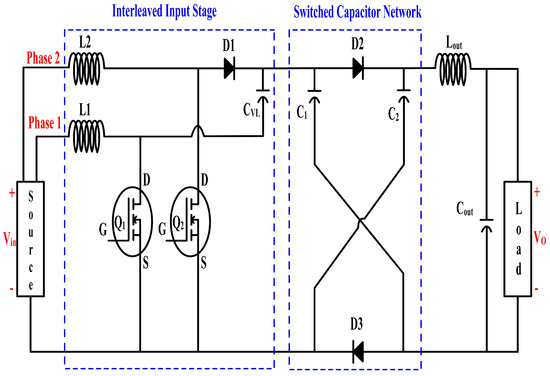
Figure 1.
Power circuit diagram of the proposed converter.
1.2. Steady State Modes of Operation
Based on the switching pattern, the overall operation of the proposed converter may be split into several distinct modes. and are the gate pulses given to the switches. and are the voltages across diodes and . and are the voltages across capacitors and .
1.2.1. Mode 1 ()
Switch is ON and switch is OFF. Diode is conducting and diodes and are OFF. The current through inductor () rises. Capacitors and discharge into the output capacitor and load through switch . This is the power delivery stage.
1.2.2. Mode 2 ()
Switches and are OFF. Diodes turns OFF and diodes and turn ON. The voltage across the source, the input inductors and the voltage lift capacitor charge the capacitors , and the load.
1.2.3. Mode 3 ()
Switches and are OFF. Diode turns ON. Diodes and turn OFF. During this mode, the output capacitor freewheels through , , and the source, i.e., the output voltage decreases.
1.2.4. Mode 4 ()
Switch remains OFF and switch turns ON. All diodes turn OFF. The output continues its freewheeling. The current through Inductor () rises. The output voltage continues to decrease.
1.2.5. Mode 5 ()
Switches and are OFF. Diodes , and are OFF. The circuit continues its freewheeling and the output voltage continues to decrease.
The characteristic waveforms are shown in Figure 2.
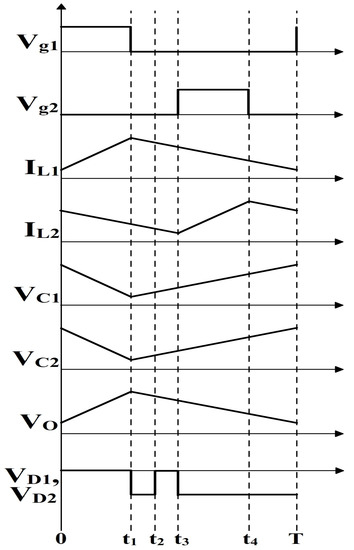
Figure 2.
Characteristic waveforms of the proposed converter.
2. Analysis of the Proposed Converter
The gain of the proposed converter can be obtained by multiplying the gain of the interleaved stage and the switched capacitor network. Figure 3 and Figure 4 show the stages individually. The gain expressions of the interleaved stage and the switched capacitor stage are analyzed separately and presented in the subsequent sections.
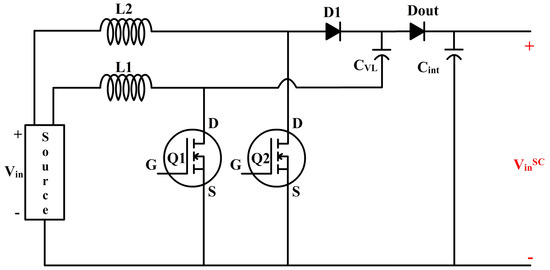
Figure 3.
Interleaved stage of the proposed converter.
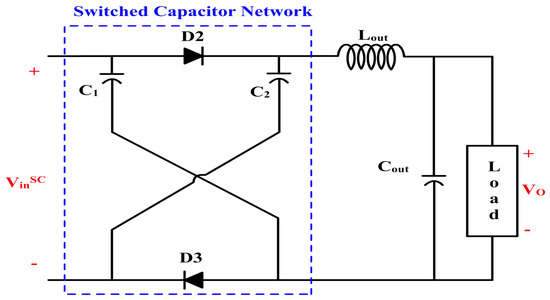
Figure 4.
Switched capacitor network of the proposed converter.
2.1. Interleaved Stage Gain
The capacitor is charged from the source by the switching of :
Consider inductor L1:
When is ON:
When is OFF:
Averaging over one cycle, we obtain the gain of the interleaved stage as follows:
This is the input to the switched capacitor network.
2.2. Switched Capacitor Network Gain
The gain of the switched capacitor network, shown in Figure 4, is discussed in detail in [23]. Following a similar method and including the voltage lift capacitor:
On the output side:
On the input side:
2.3. Overall Gain
From (10) and (15), the overall gain expression of the proposed converter can be written as:
The plot of gain vs. the duty of the proposed converter is shown in Figure 5. It is seen that this gain is significantly higher than the gains presented in [29,30,31].
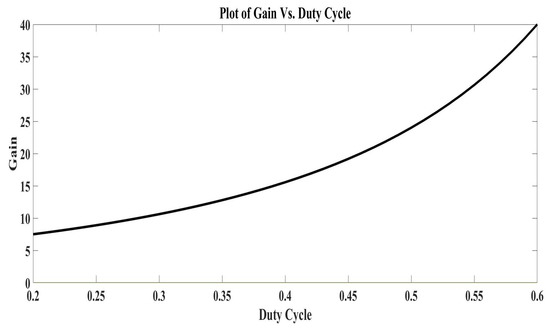
Figure 5.
Gain plot of the proposed converter.
3. Converter Design
The proposed converter was simulated in PSIM, and the results are compared to the practical results of a prototype. The hardware prototype of the proposed converter was designed for an output of 310 V/100 W. The PI control of the prototype is conducted using a Microchip PIC16F455. The feedback system maintains a constant output voltage and manages the peak overshoot and settling time. The output voltage is sensed using a LV25-P voltage sensor. Figure 6 shows the photograph of the converter prototype, and Figure 7 shows the control board with the voltage sensor and microcontroller. The overall block diagram of the proposed converter is shown in Figure 8. The details of the prototype are shown in Table 1.
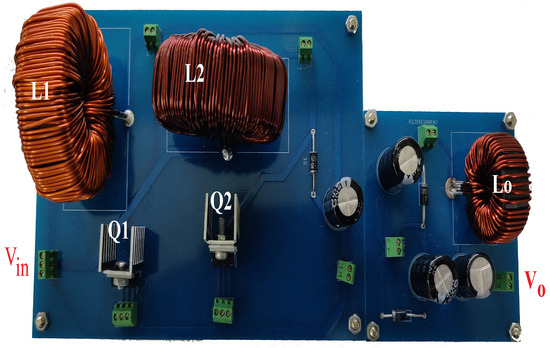
Figure 6.
Prototype of the proposed converter.
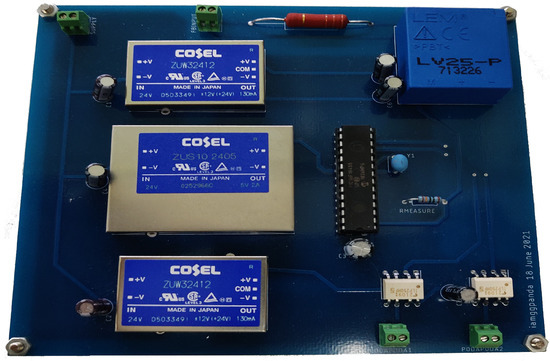
Figure 7.
Control board.
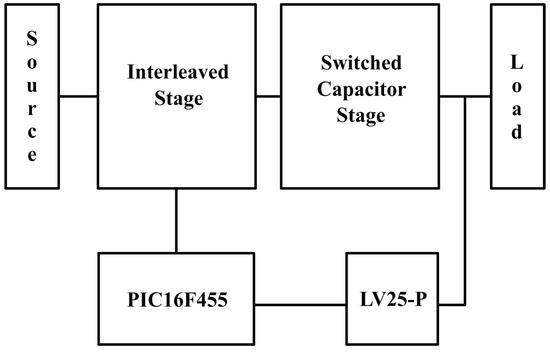
Figure 8.
Overall block diagram.

Table 1.
Prototype details.
4. Results and Discussion
The 310 V/100 W hardware prototype was tested, and the results were compared to the corresponding PSIM simulation results.
Figure 9 and Figure 10 show the hardware and simulation waveforms of hte gate pulses to switches and , the input voltage and the output voltage. The input voltage is 31.7 V, and the converter is operating at a duty cycle of 30%, delivering an output voltage of 310 V. This demonstrates the voltage gain capability of the proposed converter. The gain at this duty cycle is 10, and this matches the gain expression of Equation (16). It is seen that the results of the prototype closely match those of the simulation.
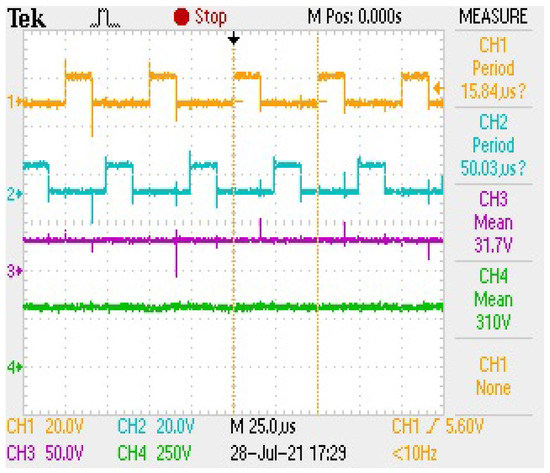
Figure 9.
Gate pulses: input voltage and output voltage.
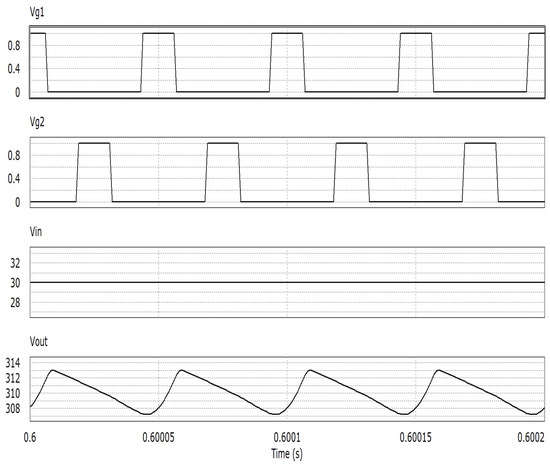
Figure 10.
Simulation of gate pulses: input voltage and output voltage.
Figure 11 and Figure 12 show the hardware and simulation waveforms of the input voltage, input current, output voltage and output current. It is seen that the average values of the simulation and hardware waveforms closely match each other. As mentioned before, one of the advantages of an interleaved input is the continuous input current, and it can be seen that the input current waveform is continuous without any major fluctuations. From these figures, we can calculate the input and output powers. It is seen that the converter is delivering an output power of 99.2 W while drawing an input power of 106.8 W. The efficiency of the converter is 92.88% without soft-switching.
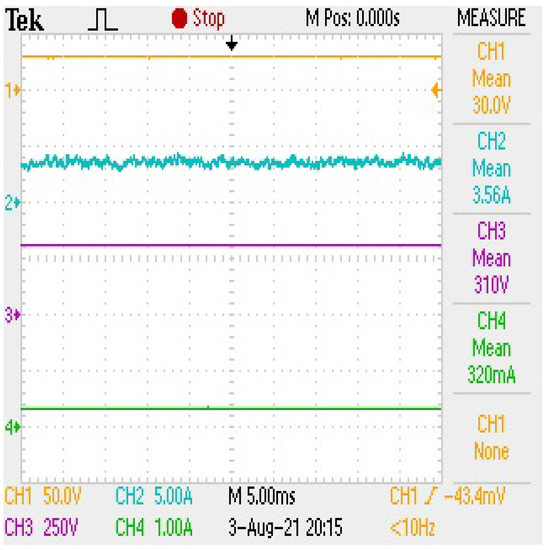
Figure 11.
Input voltage, input current, output voltage and output current.

Figure 12.
Simulation of input voltage, input current, output voltage and output current.
Figure 13 and Figure 14 show the hardware and simulation waveforms of the output voltage during startup. In the simulation waveform, the output voltage rises to a steady-state value within 400 ms. Practically, it can be seen that the output voltage rises to a steady-state value within 100 ms. This is within acceptable variation limits. It is also seen that the converter does not have any peak overshoot.
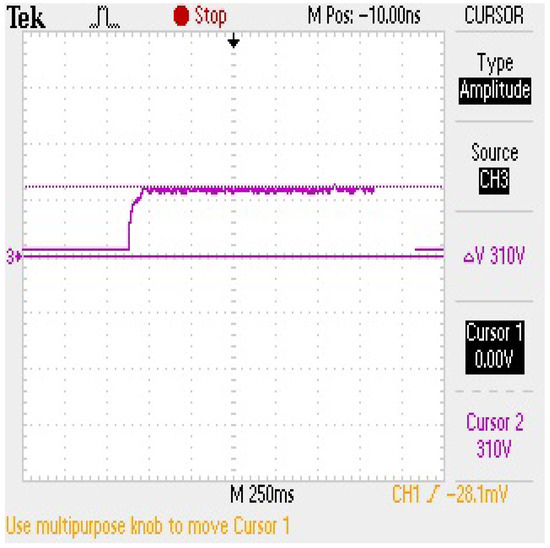
Figure 13.
Output voltage vs. time.

Figure 14.
Simulation of output voltage vs. time.
5. Conclusions
A novel, non-isolated high gain boost converter is presented. The proposed converter has an interleaved input stage and provides considerable voltage gain using voltage-lift capacitor techniques and a switched-capacitor network. The features of the converter are a high gain without an extreme duty ratio and a continuous input current. The prototype of the proposed converter operates at an output voltage of 310 V while delivering 100 W at an efficiency of 92.88%. The results of the simulation and hardware testing indicate that the proposed converter has low peak overshoot, fast settling time and good efficiency.
Author Contributions
Conceptualization, G.G.R.; investigation, G.G.R.; methodology, G.G.R.; project administration, N.U.; resources, N.U.; software, G.G.R.; supervision, N.U.; validation, G.G.R.; visualization, G.G.R.; writing—original draft, G.G.R.; writing—review and editing, G.G.R. All authors have read and agreed to the published version of the manuscript.
Funding
This research received no external funding.
Institutional Review Board Statement
Not Applicable.
Informed Consent Statement
Not Applicable.
Conflicts of Interest
The authors declare no conflict of interest.
References
- Luo, F.; Zhang, T.; Mi, Z.; Li, F.; Bai, L.; Liu, G.; Sun, Q.; Wang, X. Study on low-carbon comprehensive benefits of grid-connected photovoltaic generation. In Proceedings of the 2015 IEEE Power & Energy Society General Meeting, Denver, CO, USA, 26–30 July 2015; pp. 1–5. [Google Scholar]
- Köberle, A.C.; Gernaat, D.E.; van Vuuren, D.P. Assessing current and future techno-economic potential of concentrated solar power and photovoltaic electricity generation. Energy 2015, 89, 739–756. [Google Scholar] [CrossRef] [Green Version]
- Das, M.; Agarwal, V. Novel high-performance stand-alone solar PV system with high-gain high-efficiency DC–DC converter power stages. IEEE Trans. Ind. Appl. 2015, 51, 4718–4728. [Google Scholar] [CrossRef]
- Silvestre, S.; Chouder, A. Effects of shadowing on photovoltaic module performance. Prog. Photovolt. Res. Appl. 2008, 16, 141–149. [Google Scholar] [CrossRef]
- Eltamaly, A.M. Performance of smart maximum power point tracker under partial shading conditions of photovoltaic systems. J. Renew. Sustain. Energy 2015, 7, 043141. [Google Scholar] [CrossRef]
- Sullivan, C.R.; Awerbuch, J.J.; Latham, A.M. Decrease in photovoltaic power output from ripple: Simple general calculation and the effect of partial shading. IEEE Trans. Power Electron. 2012, 28, 740–747. [Google Scholar] [CrossRef]
- Erickson, R.W.; Maksimovic, D. Fundamentals of Power Electronics; Springer Science & Business Media: Berlin/Heidelberg, Germany, 2007. [Google Scholar]
- Maksimovic, D.; Cuk, S. Switching converters with wide DC conversion range. IEEE Trans. Power Electron. 1991, 6, 151–157. [Google Scholar] [CrossRef]
- Sreekanth, T.; Lakshminarasamma, N.; Mishra, M.K. A single-stage grid-connected high gain buck–boost inverter with maximum power point tracking. IEEE Trans. Energy Convers. 2016, 32, 330–339. [Google Scholar] [CrossRef]
- Shanthi, T.; Prabha, S.U.; Sundaramoorthy, K. Non-Isolated n-Stage High Step-up DC-DC Converter for Low Voltage DC Source Integration. IEEE Trans. Energy Convers. 2021, 36, 1625–1634. [Google Scholar] [CrossRef]
- Wu, T.F.; Chen, Y.C.; Yang, J.G.; Huang, Y.C.; Shyu, S.S.; Lee, C.L. 1.5 kW isolated bi-directional DC-DC converter with a flyback snubber. In Proceedings of the 2009 International Conference on Power Electronics and Drive Systems (PEDS), Taipei, Taiwan, 2–5 November 2009; pp. 164–169. [Google Scholar] [CrossRef] [Green Version]
- Wu, H.; Mu, T.; Ge, H.; Xing, Y. Full-Range Soft-Switching-Isolated Buck-Boost Converters With Integrated Interleaved Boost Converter and Phase-Shifted Control. IEEE Trans. Power Electron. 2016, 31, 987–999. [Google Scholar] [CrossRef]
- Andrade, A.M.S.S.; Mattos, E.; Schuch, L.; Hey, H.L.; da Silva Martins, M.L. Synthesis and comparative analysis of very high step-up DC–DC converters adopting coupled-inductor and voltage multiplier cells. IEEE Trans. Power Electron. 2017, 33, 5880–5897. [Google Scholar] [CrossRef]
- Axelrod, B.; Berkovich, Y.; Ioinovici, A. Transformerless DC-DC converters with a very high DC line-to-load voltage ratio. In Proceedings of the 2003 International Symposium on Circuits and Systems, Bangkok, Thailand, 25–28 May 2003; Volume 3, p. III. [Google Scholar]
- Girish Ganesan, R.; Prabhakar, M. Multi-level dc-dc converter for high gain applications. Int. J. Power Electron. Driv. Syst. 2013, 3, 365–373. [Google Scholar]
- Prudente, M.; Pfitscher, L.L.; Emmendoerfer, G.; Romaneli, E.F.; Gules, R. Voltage multiplier cells applied to non-isolated DC–DC converters. IEEE Trans. Power Electron. 2008, 23, 871–887. [Google Scholar] [CrossRef]
- Girish Ganesan, R.; Prabhakar, M. Non-isolated high step-up interleaved boost converter. Int. J. Power Electron. 2014, 6, 288–303. [Google Scholar] [CrossRef]
- Chen, S.M.; Liang, T.J.; Yang, L.S.; Chen, J.F. A cascaded high step-up DC–DC converter with single switch for microsource applications. IEEE Trans. Power Electron. 2010, 26, 1146–1153. [Google Scholar] [CrossRef]
- An, L.; Lu, D.D.C. Analysis of DC bus capacitor current ripple reduction in basic DC/DC cascaded two-stage power converters. IEEE Trans. Ind. Electron. 2016, 63, 7467–7477. [Google Scholar] [CrossRef]
- Sivasankar, G.; Vidhyaa, K.; Anitha, E.; Kumar, B.A.; Vairaprakash, P. Application of luo converter and multilevel cascaded converter for grid integration of solar pv systems. In Proceedings of the 2016 International Conference on Circuit, Power and Computing Technologies (ICCPCT), Nagercoil, India, 18–19 March 2016; pp. 1–6. [Google Scholar]
- Zhao, J.; Iu, H.H.; Fernando, T. The design of cascaded DC-DC converters with single-switch PWM and PFM for standalone PV power applications. In Proceedings of the 2017 IEEE 3rd International Future Energy Electronics Conference and ECCE Asia (IFEEC 2017-ECCE Asia), Kaohsiung, Taiwan, 4–7 June 2017; pp. 122–126. [Google Scholar]
- Xie, F.; Zhang, B.; Qiu, D.; Jiang, Y. Non-linear dynamic behaviours of DC cascaded converters system with multi-load converters. IET Power Electron. 2016, 9, 1093–1102. [Google Scholar] [CrossRef]
- Axelrod, B.; Berkovich, Y.; Ioinovici, A. Switched-capacitor/switched-inductor structures for getting transformerless hybrid DC–DC PWM converters. IEEE Trans. Circuits Syst. I Regul. Pap. 2008, 55, 687–696. [Google Scholar] [CrossRef]
- Liccardo, F.; Marino, P.; Torre, G.; Triggianese, M. Interleaved dc-dc Converters for Photovoltaic Modules. In Proceedings of the 2007 International Conference on Clean Electrical Power, Capri, Italy, 21–23 May 2007; pp. 201–207. [Google Scholar] [CrossRef]
- Ramabadran, R.; Balaji, K.; Raj, S.; Logeshwaran, V. Comparison of Interleaved Boost Converter Configurations for Solar Photovoltaic System Interface. J. Eng. Res. 2013, 10, 87–98. [Google Scholar] [CrossRef] [Green Version]
- Prasanth, P.; Ramalingam, S. Investigation Of Four Phase Interleaved Boost Converter under Open Loop and Closed Loop Control Schemes for Battery Charging Applications. Int. J. Adv. Mater. Sci. Eng. 2016, 5, 11–20. [Google Scholar] [CrossRef]
- Farh, H.M.H.; Othman, M.F.; Eltamaly, A.M.; Al-Saud, M.S. Maximum Power Extraction from a Partially Shaded PV System Using an Interleaved Boost Converter. Energies 2018, 11, 2543. [Google Scholar] [CrossRef] [Green Version]
- Farh, H.M.; Eltamaly, A.M.; Al-Saud, M.S. Interleaved boost converter for global maximum power extraction from the photovoltaic system under partial shading. IET Renew. Power Gener. 2019, 13, 1232–1238. [Google Scholar] [CrossRef]
- Lee, P.W.; Lee, Y.S.; Cheng, D.; Liu, X.C. Steady-state analysis of an interleaved boost converter with coupled inductors. IEEE Trans. Ind. Electron. 2000, 47, 787–795. [Google Scholar] [CrossRef]
- Arango, E.; Ramos-Paja, C.A.; Calvente, J.; Giral, R.; Serna, S. Asymmetrical Interleaved DC/DC Switching Converters for Photovoltaic and Fuel Cell Applications—Part 1: Circuit Generation, Analysis and Design. Energies 2012, 5, 4590–4623. [Google Scholar] [CrossRef] [Green Version]
- Muhammad, M.; Armstrong, M.; Elgendy, M.A. A Nonisolated Interleaved Boost Converter for High-Voltage Gain Applications. IEEE J. Emerg. Sel. Top. Power Electron. 2016, 4, 352–362. [Google Scholar] [CrossRef] [Green Version]
Publisher’s Note: MDPI stays neutral with regard to jurisdictional claims in published maps and institutional affiliations. |
© 2021 by the authors. Licensee MDPI, Basel, Switzerland. This article is an open access article distributed under the terms and conditions of the Creative Commons Attribution (CC BY) license (https://creativecommons.org/licenses/by/4.0/).